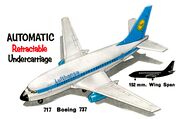Boeing 737 (Dinky Toys 717)
| Exhibit |
|---|
Boeing 737 (Dinky Toys 717) (i) (i)
|
 |
| location: |
|
Arch Two , Area 72 1970 |
Boeing 737 passenger airliner, Dinky Toys model no. 717.
The Boeing 737-100 and 737-200 entered service in early 1968. Based on the same basic nose and body cross-section as the earlier 707 (Boeing's first significant foray into passenger jet airliners), the 737 had two engines rather than the 707's four, and became the world's most popular airliner in terms of aircraft delivered.
2017: The "737 Max" variants
Not as visually distinctive as the 747 "Jumbo" jet, or perhaps even the 707, the 737 design finally caught the public's eye when it became infamous with Boeing's 2017 launch of the 737 Max, which replaced the two engines with two much larger power-plants. This change unbalanced the aircraft, and produced a tendency to occasionally put the plane into a nose-up "stall". To counteract the problem, Boeing fitted an additional system that sensed an oncoming stall and automatically threw the nose down to compensate. This turned into a nightmarish textbook case of how not to run an aircraft company – violating a proud tradition of solid aircraft design at Boeing, the management not only authorised a plane to go into service that was inherently problematic in terms of aeronautic stability, they also failed to tell pilots about the new system, since classing the anti-stall system as a "significant" change would mean that airlines would need to pay to have pilots retrained in order to be certified to fly the plane. Finally, engineers and management at Boeing committed the utterly unforgivable sin of driving the new anti-stall system from a single sensor, breaking the rule that critical systems must always have some sort of redundancy.
Perhaps motivated by the belief that the antistall system would hardly ever be in operation, and therefore wasn't worth spending too much time and money on, Boeing somehow managed to produce a aeroplane where a single sensor fault could trigger the software system to override the pilot and throw the nose down, sending the plane into a nosedive at inappropriate and unpredictable moments, without warning, and without the poor pilots even having been told that the system could do this.
Two fatal crashes in 2018 and 2019, less than six months apart, and resulting in 346 deaths (the first crash intially blamed by Boeing on pilot error), led to the grounding of the aircraft and a redesign of the MCAS avionics system.


